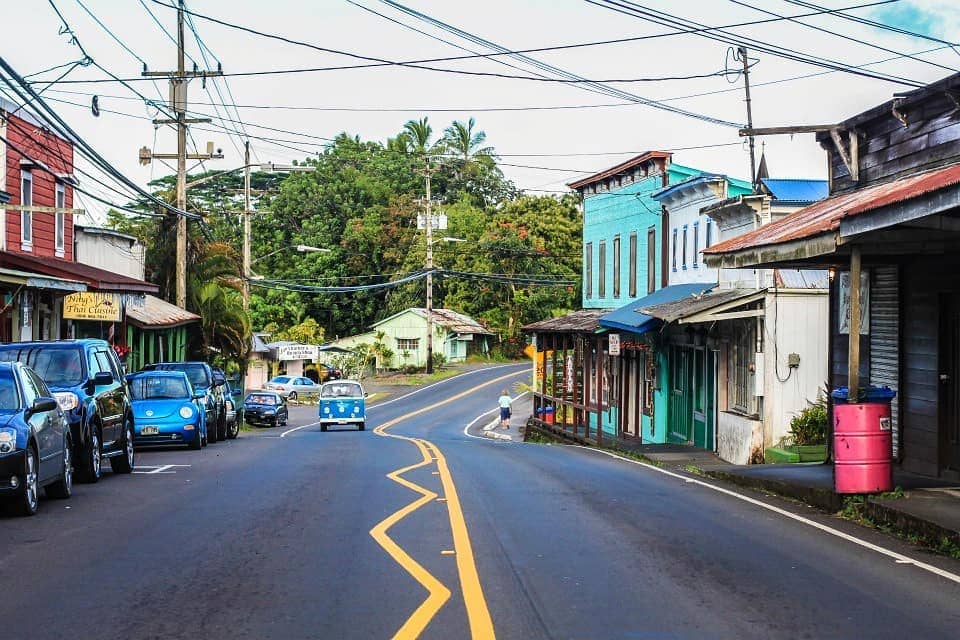Our guide will help acquaint you with the most spectacular and quintessential spots in the Puna district, a place we consider a must-see while visiting the Big Island.
Puna is one of the 9 districts of Hawaii County. Located on the windward (east) side of the Big Island, it borders South Hilo to the north and Kaʻū to the west. With an area of just under 320,000 acres (1,300 km2) or 500 sq. miles, Puna is only slightly smaller than the island of Kauaʻi.
A fertile and fragrant paradise, this area is widely regarded as the best place in the Islands to grow several crops and is home to countless nurseries and farms producing tropical flowers, macadamia nuts, papayas, bananas and tea. Surrounding these ventures are miles of lush rainforest and winding roads that hug the largely undeveloped coastline. A visit to this part of the island is truly a step back in time, and the complete absence of any permanent infrastructure is striking.
Table of contents
Before we start with our guide, a request: Please tread lightly while visiting this part of the world. The people of Puna are a happy, welcoming, and resilient bunch, but the communities here are still recovering from the events of 2018 and no one likes to feel like the recipient of disaster tourism. Drive with aloha, pay attention to signage and directions from well-meaning locals and remember to slow down, smile and enjoy your time here.
How recent history shaped Puna
The reason for the pristine nature of this area is its precarious and special location on the East Rift Zone of the Kīlauea volcano, one of the most active in the world.
Puna is an ever-changing and exceptionally risky place to call home, and the high-risk/high payoff of living here attracts a hardy crowd that has shaped the face of this frontier for decades. The result is an eclectic and colorful collection of homes and businesses, scattered through this vast expanse, that reflect the face of the brave populace willing to risk everything for a chance to live in one of the most beautiful regions in the state.
Puna captured the imaginations of spectators across the globe in 2018 when, on May 3, a fissure opened, and lava started spewing out onto a residential street in the Leilani Estates subdivision. By June, hundreds of homes in several subdivisions had been destroyed. Lasting just over 3 months, the eruption concluded in early August, at which time over 13 square miles of existing land had been covered by lava, and over 875 acres of new land was created offshore. This episode would come to be known as the 2018 LERZ eruption and its drastic effects on the region and local populace can still be seen.
Our 9 Favorite Places to See in Puna
While it’s possible to spend days exploring the many magical and hidden corners of the Puna district we understand your need to prioritize. These are our favorite sights to see in the Puna district:
- Pāhoa
- The Painted Church
- Kalapana
- Kaimū and Uncle Robert’s
- The Red Road
- Mackenzie State Park
- Pohoiki (Isaac Hale)
- Lava Tree Monument
- Maku’u Farmer’s Market
Pāhoa
Tucked into the eastern corner of the Big Island and in the heart of the Puna district is the vibrant and colorful little town of Pāhoa. In your haste to venture on into lower Puna and the areas affected by the 2018 LERZ eruption, you might think to simply pass right through, but you’d be far better served to spend some time here wandering through the quirky collection of shops, museums and galleries that line the main street, or to stop for coffee or a meal in one of its numerous cafes and eateries.
Secluded by acres of rain forest and lava flows, Pāhoa is unlike any other place you’ll find in Hawai’i and will begin to prepare you for your journey into one of the most mystical and constantly changing areas in the state.
The town came dangerously close to being devoured by lava in a 2014 eruption that started and stalled several times over the period of a few weeks, finally halting just a few miles north of the main road. The Royal Gardens subdivision and the villages of Kaimu and Kalapana were largely destroyed by these flows which eventually veered south and into the ocean at Kamokuna. In 2018 the intense glow of the LERZ eruption in Leilani Estates, just 5 miles to the north, could be seen from the main road of Pāhoa.
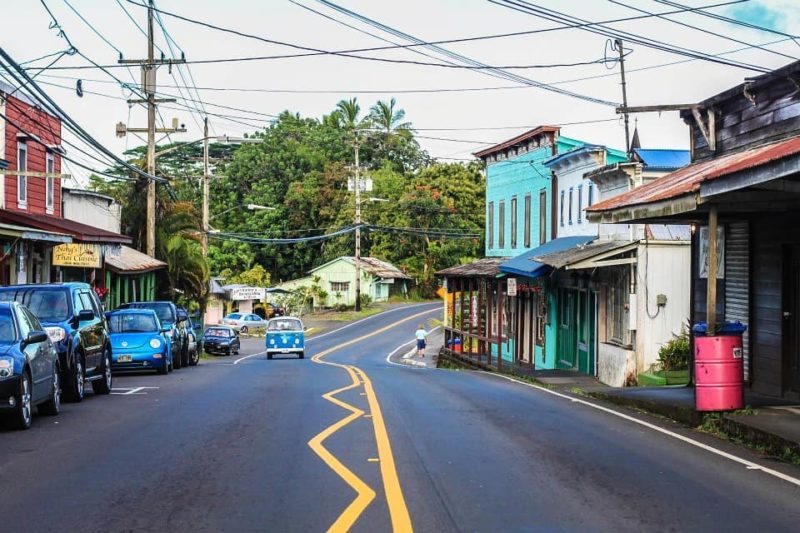
Downtown Pahoa with its raised wooden sidewalk, the false-front stores and the numerous old buildings, has a certain “Wild West” atmosphere. Image Credit: Joey Gutierrez.
The Painted Church
At the end of the main street in Pahoa, you can continue south about 10 mins on Highway 130 to the Star of the Sea Painted Church (colloquially just the Painted Church).
Built in 1928 under the direction of the Belgian Catholic missionary priest Father Evarist Gielen, the church was dramatically moved from its original location in the village of Kalapana, ahead of an advancing lava flow in 1990 that would go on to decimate the entirety of the once beautiful and beloved village.
By no means an architectural wonder, the Painted Church is a serene and beautiful spot that offers a great representation of Hawaiian folk art. A quick stop here will certainly give you more appreciation for the scope of the devastation that lies ahead on our journey.
Good to know: there is another painted church in the south Kona district, called the St Benedict Catholic Church.
Kalapana
The village of Kalapana was once one of the most picturesque spots in the Hawaiian Islands. Oozing with old-Hawaii charm, an off the beaten track feel and a healthy collection of local resident artists, it attracted many visitors to the shores of its famous Kamoamoa Beach and ancient Hawaiian Queen’s Baths.
In 1990, spectacular lava flows from the Kūpaʻianahā vent on the southeast rift zone of Kīlauea destroyed and partly buried most of the town, as well as the nearby Kalapana Gardens and Royal Gardens subdivisions, and the town and bay of Kaimū which now lie under more than 50 feet of lava. It was the most devastating flow to a residential area in the islands until the 2018 LERZ flow in Leilani Estates.
Today it is possible to drive out to the site of the old town and gaze over the vast lava fields stretching up the slopes of Kīlauea toward Puʻu ʻŌʻō. Many of the previous homeowners have rebuilt on the lava fields and the sight of the odd structure juxtaposed against the stark blackness of this veritable finisterre is eerie and humbling.
Pop trivia: Kamoamoa Beach was the shooting location for the video clip of Chris Isaak’s iconic song Wicked Game in 1989. The beach would go on to be completely engulfed by lava less than a year later.
Kaimū and Uncle Robert’s
Backtracking a bit will bring you to the turnoff for Kaimū the small neighboring town that was destroyed by the eruption in 1990. In Hawaiian, kai mū means “gathering [at the] sea” to watch surfing.
Today you can enjoy the short walk from the parking area to a new black sand beach being formed in Kaimū Bay. The sound of the waves grinding lava into pristine black sand is unique and the sight of the infant beach is an incredible reminder of the constant change and re-creation in this part of the world.
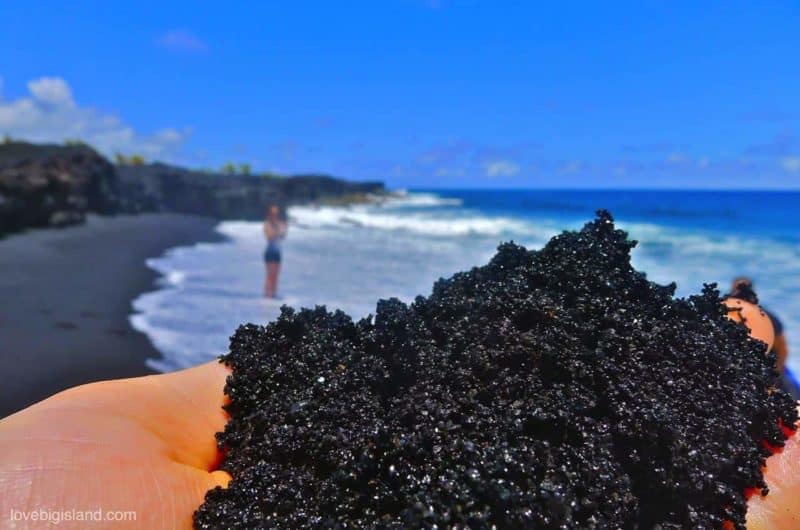
If you look closely you can see that the black sand at the beach consists out of fragments of solidified lava.
After a visit to the beach, you should stop by for a look around Uncle Robert’s, a hodge-podge collection of vendors, eateries and a kava bar open throughout the week. Wednesday night (5pm- midnight) is when things really get going here and the stalls and tables fill up with visitors and locals alike, enjoying the live music, tasty food, and the warm, festive ambiance.
The Red Road
The Kapoho-Kalapana Road, also known as the Red Road, is one of the most remote and scenic drives on the island. It winds north from Kaimū along rugged and breathtaking coastline, through lush coconut groves and tropical rainforests. The road was covered by lava at several points by the 2018 LERZ eruption and journeying along it now is a good way to get a scope of the destruction this event caused.
Take time to stop at the many scenic points and small beaches along the way while enjoying the slow pace of life in this part of the world.
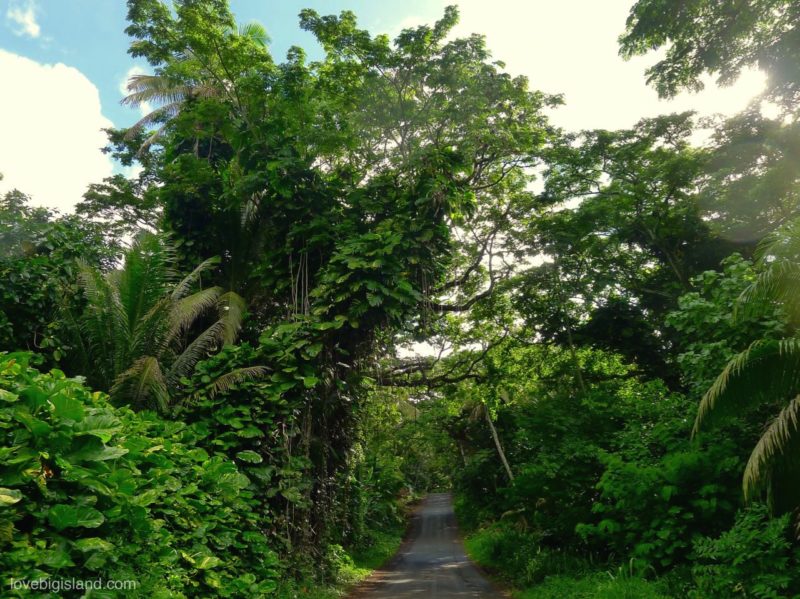
The Kalapana – Kapoho road (also known as red road) is one of the most scenic drives on the Big Island
Mackenzie State Park
Spooky and beautiful, MacKenzie State Park is a 13-acre recreation area perched on the jagged lava sea cliffs along the Red Road. The signature feature of the park is the largest stand of ironwood trees in the Hawaiian Islands and the main attraction is experiencing the raw power of the waves along the sea cliffs.
There are restrooms and a covered picnic pavilion. Camping is not advised, and rogue waves are extremely dangerous so please heed the numerous danger signs. Park entrance is free but entry into lava tubes or caves is prohibited.
Pohoiki (Isaac Hale Beach Park)
For decades, the boat ramp and beautiful surf break in Pohoiki Bay have been an iconic spot in the Puna area. Over the summer of 2018 locals and visitors alike watched with trepidation as the lava crept closer to the bay and threatened to engulf the area. When the eruption subsided, strong currents swept tons of newly formed sand from down the coast into the bay, creating the island’s newest black sand beach and warm water lagoon in front of the old boat ramp.
A short walk from the water will take you to the edges of the 2018 lava flow. Eerie and wondrous, Pohoiki is a sight to behold. Swimming is currently not advised.
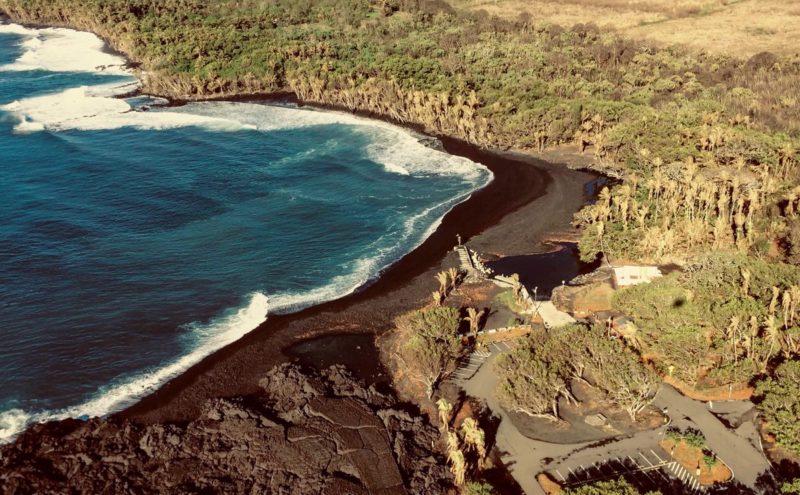
On this aerial image you can see the new beach made out of black sand and lava fragments forming in front of the Pohoiki Boat Ramp (just right of the center). Image credit: USGS
Lava Tree Monument
Off of the Pahoa-Pohoiki Road, and just outside of Pahoa Town is the strange and fascinating Lava Trees State Park. Here you can take the 0.7-mile loop trail in this 17-acre State Monument to view the unusual lava molds of tree trunks, created when a lava flow swept through the area in the 1790s, coating the trunks of indigenous ohia trees and leaving tall lava molds in its wake.
An easy and accessible walk, this is a wonderful way to see the work of Pele (the goddess of fire) and her amazing sculpture garden. Restrooms, clean water, and picnic tables on-site.
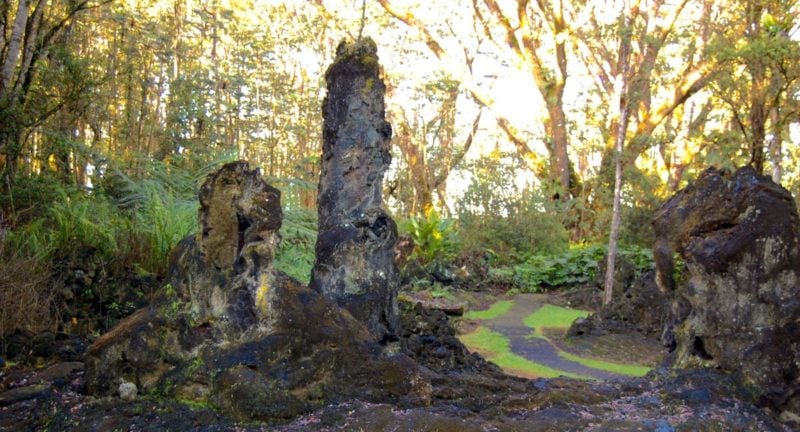
Lava trees, such as these ones on the Lava Tree State Park, are the the result of a lava flow that swept through this forested area and left behind lava molds of the tree. By Sean A. Clevenger [CC BY-SA 3.0 (https://creativecommons.org/licenses/by-sa/3.0)], from Wikimedia Commons
Maku’u Farmers Market
The Maku’u Farmers’ Market is an expansive and bustling open-air market situated just outside of Pāhoa town. Boasting over 150 vendors, the market offers up an impressive and eclectic mix of international foods, most with locally sourced and sustainable ingredients.
In addition to the vast and delicious food offerings, you can also find fresh and often organic produce from local farms nearby, homegrown or homemade products such as Puna goat cheese, local lehua honey, coffee, vanilla, macadamia nuts, chocolate, jams and pickled or baked goods. Vendors also sell handmade soaps, jewelry, and clothing, as well as crafts, pottery, books, and so much more.
A hot spot for live music and other entertainment, it is common for local residents to drop in with their whole families on Sundays to shop, explore, graze and socialize.
Note: The Maku’u Farmers’ Market (website) runs every Sunday from 8 AM to 2 PM. No pets or animals are allowed at the market, except for service dogs.
Where to Eat
All located in Pahoa, the following restaurants are good places to stop for a quick snack, lunch, or dinner while exploring Puna.
- Kaleo’s: Innovative Hawaiian-style Asian-American dishes served in a funky, relaxed space with live music.
- Ning’s: Small, charming restaurant on the main street of Pahoa, offering fresh and authentic Thai cuisine in an airy setting.
- Luquin’s: This laid-back spot dishes up generous portions of tacos, burritos, nachos & other Mexican fare.
- Pele’s Kitchen: Farm-To-Table breakfast spot featuring fresh local fruits, garden-fresh veggies, and local coffee.
- Island Natural Market and Deli: Perfect spot if you prefer to grab something to enjoy at the beach. Great selection of tasty, organic and locally sourced salads, sandwiches, sushi and hot dishes from the buffet.
Practicalities
Puna is by far the most off-the-grid district on the Big Island, and there are some things that are good to keep in mind while planning your visit.
- Weather
- Little Fire Ants
- Culture and off-limits areas
- Respectfully seeing the 2018 LERZ eruption aftermath
1: Weather
The area of lower Puna ranges from sea level to the 650ft. (200m) elevation line in Pahoa. Temperatures here are warm all year-round, alternating showers and sunshine are common, and humidity levels can easily reach 90%. Make sure to bring layer-able clothing and stay hydrated. Extra sunscreen and insect repellent also come in handy when venturing into the forested areas near ocean.
2: Little Fire Ants (LFA)
Something to watch out for while visiting the Puna area are little fire ants (Wasmannia auropunctata). As the name suggest, this species of invasive ant is tiny, but their sting packs a painful punch and is characterized by an intense and quickly spreading burning sensation.
Take care when touching or brushing against trees and other vegetation. If you are unlucky enough to be attacked by little fire ants, stay calm and brush as many of them off you as possible. Use a cool, damp towel to sooth the skin and remove any of the ants you may have missed. If swelling, itching, or burning persists for more than a few hours afterward, an over the counter hydrocortisone cream can be applied sparingly.
Little fire ants are easily transported on cars, shoes, plant materials, and produce, so also take extra care when coming and going from the area, as you may unwittingly take them along for the ride.
3: Culture and Off-limits Areas
You may have heard about Leilani Estates, ground zero of the 2018 LERZ eruption and home to Fissure 8. Leilani Estates is still a residential neighborhood and all roads except for Leilani Avenue are private. You cannot park along Leilani Avenue and the people living here do not appreciate what they perceive as disaster tourism.
Please show consideration for the residents and avoid this neighborhood altogether. You can see enough of the area while following Highway 130 to the South from Pahoa, for example at Lava Tree State Monument.
4: Respectfully seeing the aftermath of the 2018 LERZ eruption
The 2018 Lower East Rift Zone (LERZ) eruption zone is a remarkably interesting place to visit that offers a sobering perspective on the impact of eruptions on the local people and ecology of the island.
Starting in Pahoa you can stop in for a look at the Pahoa Lava Zone Museum. This is a small building featuring artifacts from the last eruption, photographs taken by locals, and exhibits from the now-abandoned Jaggar museum.
From Pahoa, follow Highway 132 to the South/East. This road was only recently rebuilt over the still-cooling lava flows that covered it in 2018 and it provides some of the best impressions. You can follow this road up to a point that used to be called “4 Corners”, but now is only one corner and the end of the road. Be careful with parking and touching the ground because the rocks in the area can still be quite hot. From here you can see a panorama of miles of new lava rock. With clear weather you can see all the way to the ocean!
Following Hwy 130 further South brings you to deeper into an area that was largely spared by the 2018 eruption, offering a glimpse into what the greater parts of the savage and wild Puna area was like before this and the many other eruptions that have shaped this part of the island. This is one of our favorite scenic drives on the island!
